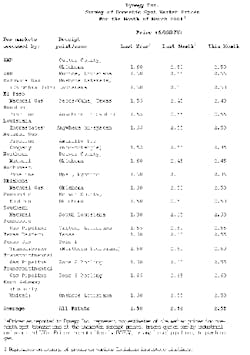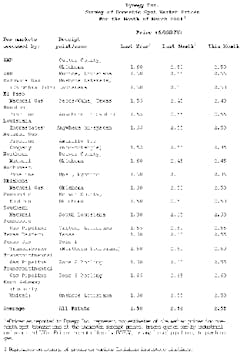Deliverability woes mean bright prospects for gas markets throughout 2000
With all the furor over oil prices today, it's easy to forget that we have something of a bull market in natural gas prices as well.
What's especially remarkable about the situation with natural gas prices is that bull market conditions-and the expectations for a bull market continuing this year-still prevail, despite an overall unseasonably warm winter to date and expectations of more of the same warmer-than-normal weather.
Of course, those unprecedentedly high (unprecedented in the sense that they were brought about through OPEC and non-OPEC solidarity on production cuts vs. a crisis) oil prices have a little something to do with that. The specter of oil trading at $32/bbl haunts all energy markets, not just oil. A lot of people in the US Northeast are probably strenuously rethinking their historic opposition to pipelines in the region and may welcome the spate of natural gas pipeline projects that have been proposed. (Funny what the sight of heating-oil tankers stymied by frozen harbors amid $2/gal heating oil can do to "not-in-my-backyard" local politics.) Even now, the heating oil "crisis" has spurred some fuel switching that has caused an extra pull on natural gas demand in recent weeks.
But with the cold temperatures ending, the additional call on gas supplies spurred by the heating oil frenzy is easing-beyond that typical for weather conditions such as these.
Right now, the natural gas market in North America would be entering a relative comfort zone for natural gas storage at this time of the year. Entering another period of unseasonably warm weather as the end of the heating season approaches would suggest end-season storage levels at a level adequate enough to avoid concerns over supply later in the year. In fact, while the year-to-year storage situation and week-to-week price conditions have remained relatively flat in the past few weeks, it is instructive to note at what level that flatness resides.
For last week's natural gas inventory data, the American Gas Association reported a 74 bcf storage withdrawal, vs. a withdrawal of 136 bcf in the prior week, a 128 bcf withdrawal for the same week a year ago, and a 47 bcf withdrawal for the same week in 1998. Here's the big difference: the year-to-year storage deficit last week stood at 468 bcf, compared with a deficit of 522 bcf the previous week and a deficit of 483 bcf in the week prior to that. With storage withdrawals likely to average less than 100 bcf this week, don't expect the year-to-year deficit to change much.
Looking at working gas in storage, a current level of 1.194 tcf compares with a level of 1.662 tcf the same time in 1999. That compares with a prior 3-year average of 1.317 tcf and a prior 5-year average of 1.264 tcf. Supplies are only 30% full in the all-important high-consuming East region vs. 40% full in the "producing" region and 35% fill in the West.
During the past 6 years, the rate of withdrawal from storage from this point until the traditional start of the injection season on Apr. 1 has been about 50 bcf/week. If that pattern continues to hold true (for which we're not holding our breath, given the weird state of weather these days), then the natural gas industry would end the withdrawal season with only 933 bcf in storage.
That's a remarkably low level for an unseasonably warm heating season. It compares with end-season storage levels of 1.337 tcf in 1999, 1.06 tcf in 1998, and an average of 972 bcf during the preceding 6 years.
That sets the stage for a robust price scenario for the near term, according to PaineWebber: "Though mild weather continues to preclude sufficient heat-load demand, the combination of early injections, material nuclear capacity off-line for scheduled maintenance, and ongoing deliverability issues will likely support the spot market above our $2.20/MMbtu March expectations," the analyst said (see table, below).
That's a pretty healthy price level for this time of the year, but nothing to get overly excited about. So why are futures markets so bullish? The April contract closed at a whopping $2.80/MMbtu yesterday, up more than a dollar from the same time a year ago. And the picture holds the same for the rest of the year. Futures contract prices range from $2.82 to $2.86 from April through September this year, and the 12-month strip is averaging about $2.91, which is up almost 25
It is abundantly clear that market expectations are for a continuing tight balance in supply and demand for natural gas this year, and that is the case regardless of a winter heating season that has been disappointing from the demand side. The key here is that supply has been even more disappointing (if that's the right word), falling far short of expectations. Continuing limitations in wellhead deliverability stem from a number of things, including a ramp-up in E&P spending that is still slow to get under way in earnest, and the likelihood that much of those E&P dollars budgeted will be directed toward oil and away from gas.
Even as oil prices seem to moderate with the approach of a watershed OPEC meeting, and even if this summer's temperatures are cooler than normal, thus denting gas demand, the die is pretty much cast: It will be a good year for gas producers as well as oil producers.
Table 1
null
OGJ Hotline Market Pulse
Latest Prices as of March 3, 2000
null
null
Nymex unleaded
null
Nymex heating oil
null
IPE gas oil
null
Nymex natural gas
null

